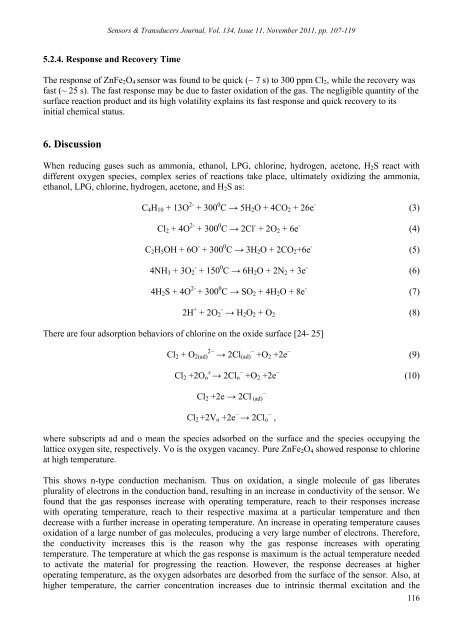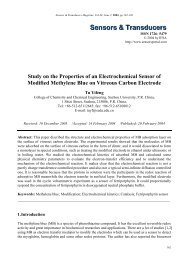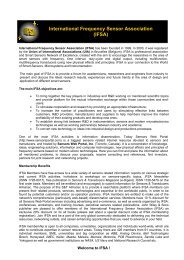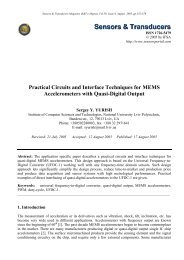Nanostructured Spinel ZnFe2O4 for the Detection of ... - ResearchGate
Nanostructured Spinel ZnFe2O4 for the Detection of ... - ResearchGate
Nanostructured Spinel ZnFe2O4 for the Detection of ... - ResearchGate
- No tags were found...
You also want an ePaper? Increase the reach of your titles
YUMPU automatically turns print PDFs into web optimized ePapers that Google loves.
Sensors & Transducers Journal, Vol. 134, Issue 11, November 2011, pp. 107-1195.2.4. Response and Recovery TimeThe response <strong>of</strong> ZnFe 2 O 4 sensor was found to be quick (~ 7 s) to 300 ppm Cl 2 , while <strong>the</strong> recovery wasfast (~ 25 s). The fast response may be due to faster oxidation <strong>of</strong> <strong>the</strong> gas. The negligible quantity <strong>of</strong> <strong>the</strong>surface reaction product and its high volatility explains its fast response and quick recovery to itsinitial chemical status.6. DiscussionWhen reducing gases such as ammonia, ethanol, LPG, chlorine, hydrogen, acetone, H 2 S react withdifferent oxygen species, complex series <strong>of</strong> reactions take place, ultimately oxidizing <strong>the</strong> ammonia,ethanol, LPG, chlorine, hydrogen, acetone, and H 2 S as:C 4 H 10 + 13O 2- + 300 0 C → 5H 2 O + 4CO 2 + 26e - (3)Cl 2 + 4O 2- + 300 0 C → 2Cl - + 2O 2 + 6e - (4)C 2 H 5 OH + 6O - + 300 0 C → 3H 2 O + 2CO 2 +6e - (5)4NH 3 + 3O 2 - + 150 0 C → 6H 2 O + 2N 2 + 3e - (6)4H 2 S + 4O 2- + 300 0 C → SO 2 + 4H 2 O + 8e - (7)2H + + 2O 2 - → H 2 O 2 + O 2 (8)There are four adsorption behaviors <strong>of</strong> chlorine on <strong>the</strong> oxide surface [24- 25]Cl 2 + O 2(ad) 2− → 2Cl (ad) − +O 2 +2e − (9)Cl 2 +2O ox→ 2Cl o − +O 2 +2e − (10)Cl 2 +2e → 2Cl (ad) −Cl 2 +2V o +2e − → 2Cl o − ,where subscripts ad and o mean <strong>the</strong> species adsorbed on <strong>the</strong> surface and <strong>the</strong> species occupying <strong>the</strong>lattice oxygen site, respectively. Vo is <strong>the</strong> oxygen vacancy. Pure ZnFe 2 O 4 showed response to chlorineat high temperature.This shows n-type conduction mechanism. Thus on oxidation, a single molecule <strong>of</strong> gas liberatesplurality <strong>of</strong> electrons in <strong>the</strong> conduction band, resulting in an increase in conductivity <strong>of</strong> <strong>the</strong> sensor. Wefound that <strong>the</strong> gas responses increase with operating temperature, reach to <strong>the</strong>ir responses increasewith operating temperature, reach to <strong>the</strong>ir respective maxima at a particular temperature and <strong>the</strong>ndecrease with a fur<strong>the</strong>r increase in operating temperature. An increase in operating temperature causesoxidation <strong>of</strong> a large number <strong>of</strong> gas molecules, producing a very large number <strong>of</strong> electrons. There<strong>for</strong>e,<strong>the</strong> conductivity increases this is <strong>the</strong> reason why <strong>the</strong> gas response increases with operatingtemperature. The temperature at which <strong>the</strong> gas response is maximum is <strong>the</strong> actual temperature neededto activate <strong>the</strong> material <strong>for</strong> progressing <strong>the</strong> reaction. However, <strong>the</strong> response decreases at higheroperating temperature, as <strong>the</strong> oxygen adsorbates are desorbed from <strong>the</strong> surface <strong>of</strong> <strong>the</strong> sensor. Also, athigher temperature, <strong>the</strong> carrier concentration increases due to intrinsic <strong>the</strong>rmal excitation and <strong>the</strong>116















